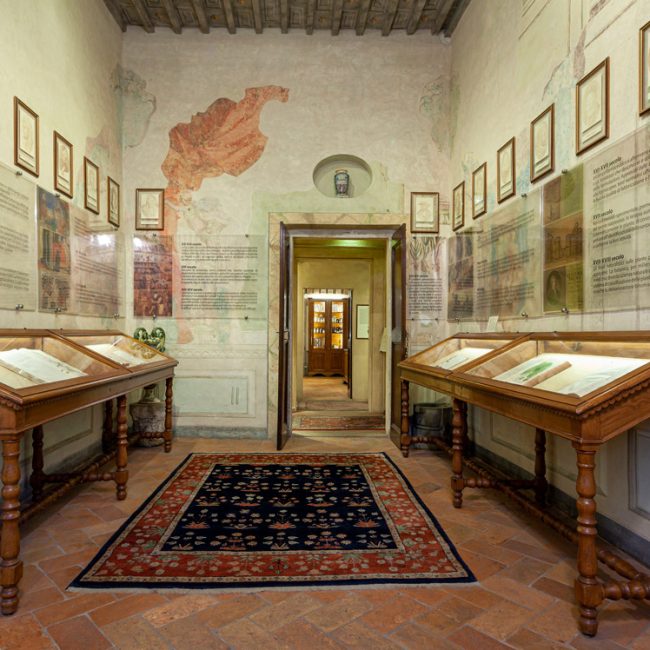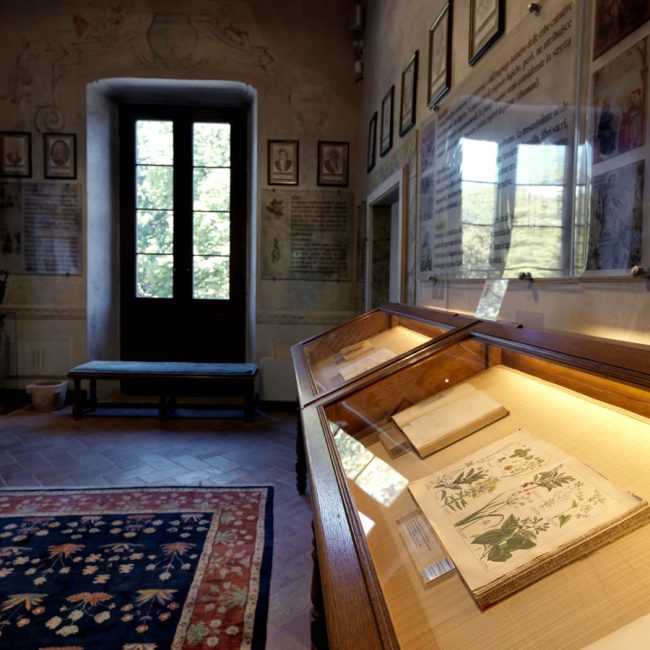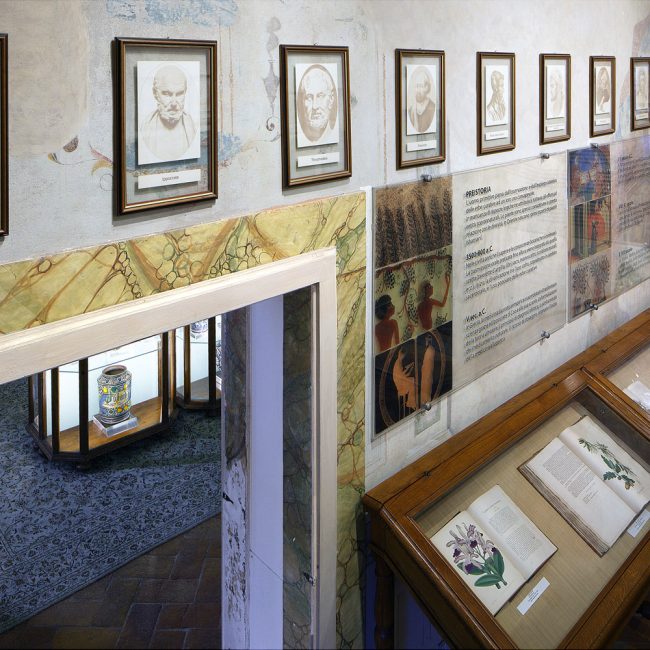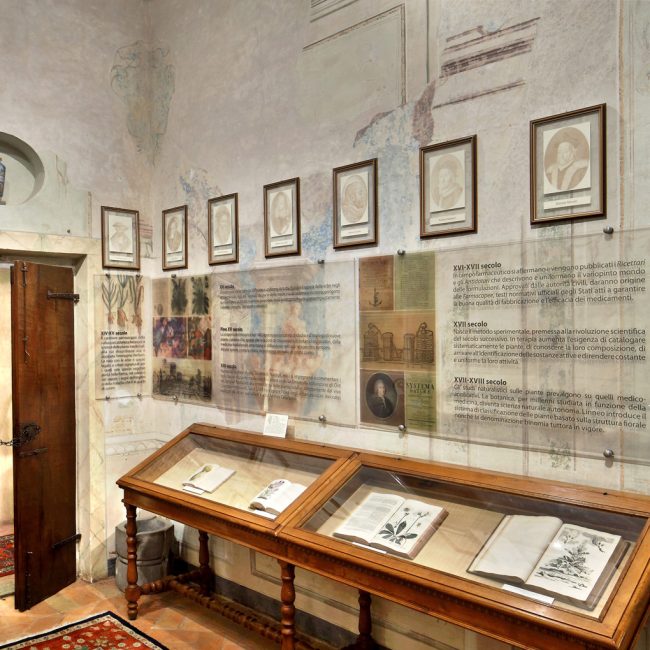The History Room
Medicinal herbs placed in their historical context
Asclepius, the Greek god of medicine; Hippocrates, the father of medicine; Galen, from whose name derives the Galenic art of preparing medicines; Lavoisier, French chemist; Linnaeus, biologist and father of the modern scientific classification of living organisms, are just some of the names of the illustrious figures who survey the visitor from above as soon as they cross the threshold.
In this room the specificity of the museum begins: medicinal herbs placed in their historical context.
The panels in the room guide us on this journey through time and recount how man has used medicinal plants over the centuries, from Prehistory to the Middle Ages, from the discoveries of the 15th century to the present day.
Preserved in the wall display cabinets are herbals which expand the collection already seen in the mortar room and testify to the technical and scientific progress in the realisation of these masterpieces of knowledge and art.
Historical – Phylosophical Extension
HERBALS
The need of representing the medicinal plants is born togethere with the idea of describing them. The illustration compensated for the inaccuracies of the text and helped to identificate botanical species. The oldest herbal is that of Crateva, doctor of Mithridates VI (IInd century BC), known for his great culture on poisons. One of the oldest herbarls existing in the West is De Materia Medica by Dioscoride, who worked in Rome in the 1st century A.C. The herbal represented a synthesis of science, botany, medicine and art. It was also used for the Roman Academy. It was a vademecum for doctors and students of the time, used to recognize medicinal plants and to memorize their therapeutic properties. With the advent of printing and the refinement of engraving techniques, the herbarium played a fundamental role in the dissemination of botanical knowledge.
Many became true flower-books. Today the term herbal means collection of dried plants for methodological and scientific purposes.
HISTORICAL NOTES
PREHISTORY
Primitive man passes from observation and instinctive employment of curative herbs to an intelligent use of them. But in lack of logical answers he attributes the effects to supernatural entities. Plants often are considered in tightened relation with divinity. The first plants experts are born (shamani).
3500-800 B.C.
Knowledge and acquaintances are developed during ancient civilizations.The oral transmission, practiced until then, is integrated with the written one’s (sacred clay tablets, books, manuscripts, registrations walls, etc). Here begin the gap between the cultured use, above all in sacerdotal within, and the popular use of curative herbs.
V SEC. B.C.
In Greece, medicine get transformed from empiricist or sacerdotal practice to science thanks to Ippocrate from Coo and its school. The formulation of umorale theory, the principle of olistic diagnosis, the aimed choice of natural medicine, the dosage resource, marks the beginning of allopatic medicine.
I-II SEC A.C.
In Rome Dioscoride and Galeno were figures that remained undisputed for all the Middle Ages and beyond. The first one catalogues in organic way the plants’ curative properties, the second introduces experimental and analytical method, the concept of complexion in umorale theory and composed preparations.
IX-XI SEC.
Monks take care of sick people. Monastic medicine starts developing. The great abbeys are supplied of infirmary, pharmacias and gardens for medicinal plants, or for simple medicines (Hortus conclusus). Arabs inherit the Greek medical tradition and introduce ancient medical books in the West.
X-XIII SEC.
In a lay environment, Salernitan Medical School constitutes an happy convergence of medical culture. Latin tradition, in fact, get mixed with Greek-oriental medical culture rethought and commented from Arabs. The interest for dietetic and hygiene integratea and completes the acquaintances in the field of therapy with plants.
XII-XIII SEC.
Crusades, the birth of Navy Republics and the consequent trade activation create a direct and constant flow of exotic remedies; on one side Europe and on the other Africa, Middle-East and Asia; as an example senna, bezoar and alcohol, which get place permanently side by side to the native one’s.
XIII SEC.
University arises, cultural centres which, although permeated with Aristotelian-Galenic dogmatism, lay the foundations for the future development of rational knowledge, of which Alberto Magno has been one of the greastest figures. In medicine the study of medicinal plants remains fundamental: the apothecry figure is born, in charge of medical preparations.
XIII-XIV SEC.
L’alchimia si pone il problema della composizione della materia e della trasmutazione dei metalli. Per quanto riguarda in particolare le piante si pone alla ricerca della quintessenza (quinta essentia), cioè della sostanza responsabile dell’attività terapeutica. Anche l’alcool permette di ottenere estratti più efficaci. Alchemy places the problem of matter’s composition and metal transmutation. With regard to plants in particular, it is the research of the quintessence (fifth essentia), that is the substance responsible for the therapeutic activity. Alcohol can also be used to obtain more effective extracts
XIV-XV SEC.
The Pan-European character of academic culture helps medicinal plants science to develo. In this period begin the use of associating the image of the plant to its description (herbari), even if this decision was related with the idea that every medical plant is connected by the color, the shape and by the taste with the organ or the disease it can cure.
XV SEC.
Press invention conforms medicinal plants’ knowledge in all Europe, although just in well-educated environment. Come up contrasting aspects between the uses of the accademic medicine and those of the empiricist, used in popular environement, where we find figures not always estimated as for exemple witches. etc.
FINE XV SEC.
The discovery of America in 1492 opens new horizons of study and employment for medicinal plants. Many plants pass from traditional american medicine to current therapeutic use thanks to missionaries and explorer. Some species, like cinchona, will cover a prominent role.
XVI SEC.
Aumentano gli studiosi (Fuchs, Dodoneo, Mattioli, ecc.) che osano commentare i testi classici di piante medicinali fino ad allora usati. Le università istituiscono gli Orti dei Semplici per la conoscenza delle piante salutari direttamente dal vivo (Ostentio simplicium). Cesalpino lancia l’idea degli erbari essiccati (exiccata).
Medicinal plants studies increase (with Fuchs, Dodoneo, Mattioli, etc.), they dare to comment classic botanical books untill then used. Universities institute the “Garden of simple” for studying herbs directly from alive (the Ostentio simplicium). Cesalpino creates the idea of pressed plants herbals (exiccata).
XVI-XVII SEC.
In campo farmaceutico nascono i ricettari e gli antidotari, che descrivono e uniformano il variopinto mondo delle formulazioni. Approvati dalle autorità civili, daranno origine alle farmacopee, testi normativi ufficiali atti a garantire la buona qualità di fabbricazione e l’efficacia dei medicamenti.
Recipes and antidotes books start to born, they describe and conform formulation’s world. They are approved by civil Authorities and will give origin to the future Pharmacopoeias, official normative books which guarantee the good fabrication quality and the effectivness of medicines.
XVII SEC.
Experimental method born and its development is an important prerequisite for the scientific revolution of the next century. In therapy increases the requirement to catalogue plants systematically, to know their composition, to arrive to the identification of active substances and to make their activity constant and uniform.
XVII-XVIII SEC.
Naturalistic studies prevail over medical-applied ones. Botany, which was studied for thousands years in function of medicine, becomes an independent science. Linneo introduces a classification system for plants based on the fiorale structure as well as binomial dénomination, still in use.
XVII-XVIII SEC.
Beginning from Paracelso spagiria, heir of alchemy, is transformed in iatrochimica, a science which attribuites the physiological and pathological processes dependence to chemical phenomena. The bases for chemical and structural research start up and it will determine the decay of plants’ use.
XIX SEC.
At the beginning of the XVIIIth century in biology a doctrine about cellular organismes is formulated (even though cell is already known from two centuries before) and in chemistry we assist at the first success about isolation of plants’ active substances. The first isolated substance is morphine in 1805, followed by others like chinina.
XX SEC.
Modern chemistry isolates and copies single molecules from plants and then produces them industrially by synthetic way. This step is due to various productive difficulties, but mainly from the possibility to patent the synthetic substances and not the natural ones.
THIRD MILLENNIUM
Man will not be able to survive if he continues to exceed biological laws. This new awareness is opening new and modern spaces of research on medicinal plants (difficultly patentable) in contrast to genetically modified products (patentable).
